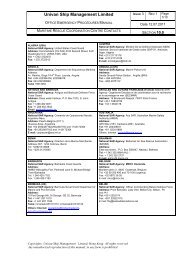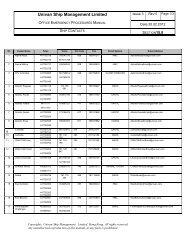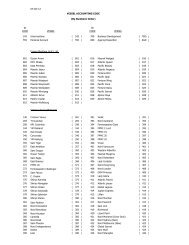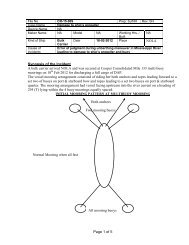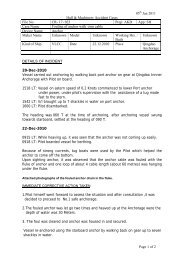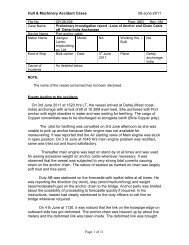Section: 11 CARGO OPERATIONS - Univan
Section: 11 CARGO OPERATIONS - Univan
Section: 11 CARGO OPERATIONS - Univan
Create successful ePaper yourself
Turn your PDF publications into a flip-book with our unique Google optimized e-Paper software.
<strong>Univan</strong> Ship Management Limited Issue 1 REV 0 Page<br />
2/2<br />
FLEET OPERATION MANUAL Date 01.01.2005<br />
<strong>CARGO</strong> CARE AND SAFETY ROUTINES DURING THE VOYAGE<br />
Copyrights: <strong>Univan</strong> Ship Management Limited, Hong Kong. All rights reserved<br />
Any unauthorized reproduction of this manual, in any form is prohibited<br />
SECTION <strong>11</strong>.6<br />
No condensation or water in the bilges. If there is some water in the bilge pump it<br />
out.<br />
Check for any leakage of oil or grease from the ship’s pipes or structure or wire<br />
ropes.<br />
Any leakage of ballast water from the pipes and valves.<br />
Any foul smell in the cargo compartments.<br />
Daily record soundings of cargo hold bilges should be maintained. Remember<br />
any leakage in the cargo area will cause a large free surface moment to form,<br />
which may be extremely dangerous to the stability of the vessel.<br />
In any foreign material such as piece of rust is found lying on the car body, No<br />
attempt should be made to remove, or else this may scratch the car paint.<br />
7) Check for any cargo damage during the voyage. If any such damage is noted inform<br />
<strong>Univan</strong> and the charterers or the owners, as the case may be. And also preserve all<br />
evidence of damages.<br />
8) On inspection, if you find that some of the cars are loaded in such conditions that they<br />
may face difficulty in discharging. Such cars must be marked with High Damage Potential<br />
cars by sticking a label on to the wind screen.<br />
9) Check for port separation is correctly marked. If not mark it correctly.<br />
You may check the integrity of the gas tight doors by running the fans, closing the gas tight<br />
doors and placing the separation tape next to the rubber joint. If the separation tape moves<br />
there is a leak in the gas tight door. Otherwise there is no leak.<br />
<strong>11</strong>.6.2 Ventilation<br />
On a Pure Car Carrier the ventilation system for the cargo spaces should be maintained in<br />
good order. Ventilation should not only be carried out in port, but also at sea to remove any<br />
accumulation of flammable gases.<br />
Keep in mind the following points regarding ventilation<br />
1) Ventilation system should be in top condition.<br />
2) The damper flaps should be rust free. As rust as well as moisture can cause stain<br />
damages to cars.<br />
3) Do not do the ventilation during rough seas. Keep all dampers in closed position.<br />
Otherwise you may have stain damages from sea sprays.<br />
4) Check the gas in cargo compartment as daily routine and operate ventilation fans.<br />
5) Before starting ventilation do the following checks:<br />
The dampers should be in open position.<br />
Confirm 3 generators are running to take the load of fans<br />
Carry out the lamp and alarm test on the fan switch panel.<br />
Start the fan, confirm indicator light is on and fans actually running<br />
6) Before arrival ports please ensure all the cargo spaces are gas free and there is no<br />
smell and bad odour in the cargo space. This is important because there have been<br />
delays to vessel because of complaints from the stevedores and long shore men.



